The tailbone is located at the bottom of the spine, consists of vertebrae that have grown together. In most cases, a violation of its functioning occurs as a result of physiological aging of the human body. Sometimes pain and discomfort occur against the background of pathological processes.
A physician therapist will help to establish an accurate diagnosis and choose the most effective treatment. A timely response to characteristic symptoms and disorders will help prevent serious complications.
Record content:
-
1 Human tailbone anatomy
- 1.1 Structure and muscular apparatus
- 1.2 Functions
- 2 Features and differences in the structure of the sacrum and coccyx in women and men
- 3 What is sacralization and lumbarization?
- 4 Causes of pain in the coccyx and sacrum area
- 5 Common diseases of the sacrum and coccyx
- 6 Methods for diagnosing tailbone pathologies
-
7 Disease treatment methods
- 7.1 Drugs
- 7.2 Surgical intervention
- 7.3 Folk remedies recipes
- 7.4 Exercise therapy
- 8 Coccyx video
Human tailbone anatomy
The tailbone is the final section of the spine. The remnants of the caudal body are vestigial vertebrae that fuse together. When damaged or as a result of a certain disease, severe pain appears, which makes it difficult for a person to sit, stand and move.
Structure and muscular apparatus
The coccyx includes 3-5 vertebrae, which gradually grow together throughout a person's life. Most often this happens before the age of 12-15. Only the upper vertebra remains mobile, against which the coccyx sometimes bends.
For the female body, this moment is positive, since the mobility of the element facilitates the birth of a baby. In men, all the vertebrae of the coccyx are in most cases completely fused.
The muscular apparatus consists of the following muscles:
| Name | Description |
| Pubic-coccygeal muscle | The muscle connecting the pubis and tailbone compresses the vagina and distal rectum, and also takes part in lifting the anus. In the male body, the pubococcygeal muscle is responsible for the tone of the prostate gland, it contracts during orgasm. |
| Iliac-coccygeal | The muscle that forms the tendons located between the rectum and the top of the tailbone. The iliococcygeus muscle is responsible for lifting the pelvic floor. |
| Recto-coccygeal muscle | The muscle starts from the 2nd and 3rd sections of the lower spine, parallel to the muscle fibers of the rectum. |
| Coccygeal | Beginning in the ischial spine, the anterior edge connects to the muscles that lift the rectum. |
| Sphincter | The annular structure that surrounds the anus, due to which it resembles a longitudinal slit in shape. |

Due to the muscles, tendons and ligaments that attach to the tailbone, it is an important part of the body.
Functions
The tailbone is located in a person in the end of the spine and its main function is to maintain the work of the musculoskeletal system. Thanks to him, the internal organs are also in the correct position.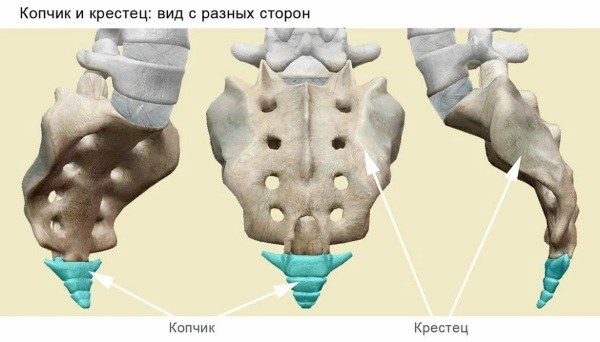
Among other functions of the coccyx, the following responsibilities should be highlighted:
- relief of labor;
- maintaining the pelvic organs by fixing the muscles on the tailbone;
- partial fixation of the gluteus maximus muscle;
- the location of the nerve plexus, from which the nerves diverge to the pelvic organs;
- additional support during squats, bends and other body movements.
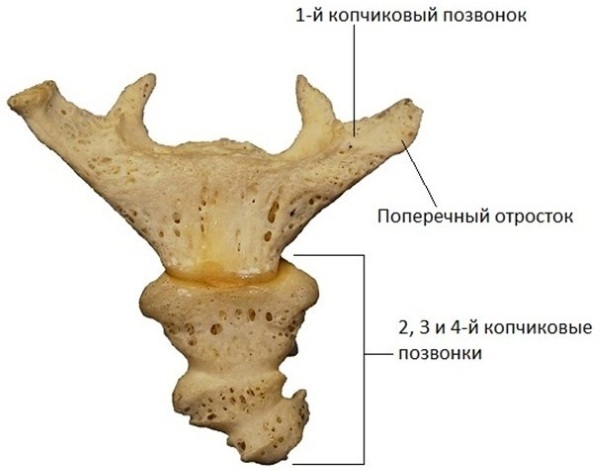
The tailbone allows you to evenly distribute the load on the spine. It also provides mobility to the hip joint, protects internal organs, and helps the skeleton in an upright position.
Features and differences in the structure of the sacrum and coccyx in women and men
The fairer sex is more often faced with the defeat of the coccyx and sacrum due to the anatomical structure of this part of the body. In women, it is short, wide and less curved.
Due to its great mobility, the tailbone can deviate by 8-14 degrees. Due to this feature, during labor, the opening in the pelvic area increases, which allows the baby to pass through it more easily. In men, the tailbone is less mobile, so it is less likely to be injured or bruised.
What is sacralization and lumbarization?
Among the anomalies that disrupt the development of the base of the spinal column and sacrum, there are pathological processes such as lumbarization and sacralization. In the first case, there is no fusion of the uppermost vertebra of the coccyx, it moves freely.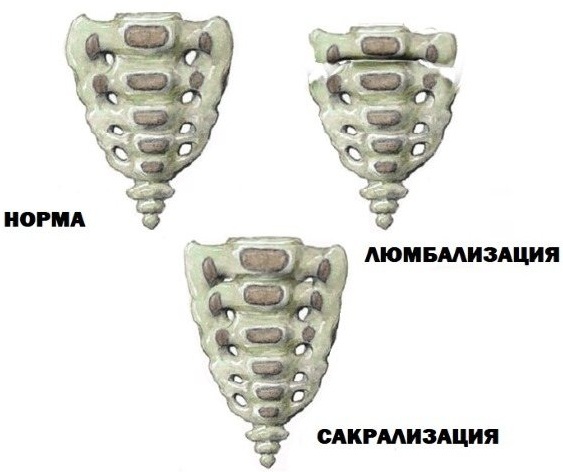
With sacralization, the lower vertebra of the lower back fuses with the ilium or sacrum. In some situations, pathological processes provoke an increase in the transverse processes of the vertebra. Their shape also changes. The articulation or separation of the vertebrae from the sacrum occurs partially or completely.
Causes of pain in the coccyx and sacrum area
The tailbone is located in the back of a person and in most cases its damage occurs due to physical impact (injury, damage). But there are other factors as a result of which a person has unpleasant sensations in the lumbar region, sacrum.
| Name | Description |
| Injury | Damage to the tailbone often occurs as a result of labor, after an unsuccessful fall, or with a precise blow to the lumbar region. The injury is accompanied by severe painful sensations, hematomas appear, soft tissues swell. Pain disturbs a person even during the act of defecation. Difficulties appear when the patient wants to sit down or bend over. |
| Pilonidal disease | Pilonidal cyst or epithelial coccygeal passage. This disease is characterized by the formation of fistulas in the skin through the hair follicle. Pathology is accompanied by painful sensations, accumulation of a small amount of pus. At the site of cyst formation, the skin swells and becomes inflamed. Sometimes the illness is accompanied by a high fever.
|
| Tumors in the sacrum and coccyx | Malignant processes in the coccyx area provoke the appearance of osteosarcoma, teratoma or chondrosarcoma. The pain syndrome with the tumor is so strong that even drugs cannot help reduce it. |
| Obesity | In the case of extra pounds, the tailbone begins to hurt due to the increased load on it, especially when a person is sitting. |
| Idiopathic pain | Coccygodynia in most cases develops for no reason. Clinical symptoms go away on their own. Pain syndrome periodically bothers, becomes chronic, so doctors prescribe painkillers to patients for a single dose. |
In each case, a person develops characteristic clinical signs, with which it is important to go to the hospital in a timely manner. A correctly established diagnosis will allow you to start treatment as soon as possible and prevent negative consequences.
Common diseases of the sacrum and coccyx
The tailbone is located in a person in the lower part of the spine from the back. Pain syndrome with its defeat can be the result of not only trauma. Discomfort and other symptoms appear as a result of the development of pathological processes. A comprehensive examination and a doctor will help to establish an accurate diagnosis.
| Name | Description |
| Osteochondrosis | A disease characterized by the formation of bone growths (osteophytes). In this case, strong painful sensations appear, since the neoplasms put pressure on the nerve endings. The disease is also accompanied by numbness in the affected area, the appearance of goose bumps and a burning sensation. |
| Lumbosacral spondylosis | The disease faced by people of different ages. Pathology occurs more often against the background of osteochondrosis, as a result of a degenerative-dystrophic process in the intervertebral discs. The destruction of cartilage tissue occurs, the body tries to compensate for the changes, as a result of which osteophytes appear. |
| Lumbar protrusion | The disease is characterized by protrusion of the vertebral discs, which have a protective function. Pathological processes provoke a decrease in the elasticity and height of the cartilage. Progressive changes lead to the formation of an intervertebral hernia, when the integrity of the membrane of the annulus fibrosus is disrupted. |
| Lumbar hernia | Complication of chronic lumbosacral osteochondrosis. Degenerative-dystrophic disease, as a result of which the annulus fibrosus gradually collapses. |
| Sciatica | A pathological condition characterized by an infringement of the sciatic nerve. There is a strong pain syndrome in the coccyx, buttocks and the back of the thigh.
|
| Lumbodynia | A disease in which there is a lumbago in the lumbar region. The main reason is pinching of the nerve endings, resulting in severe pain and stiffness. Muscle spasm limits a person's mobility. Lumbodynia in most cases occurs against the background of a hernia, protrusion or osteochondrosis of the spine. |
| Other diseases | Painful sensations in a person often arise not only as a result of damage to the coccyx itself. Many pathologies are masked in this way. We are talking about hemorrhoids, dysbiosis, cystitis, prostatitis, inflammation of the ovaries and other organs of the reproductive system. The same applies to lesions of the genitourinary system and the musculoskeletal system. |
A congenital anomaly is the complete absence of the coccyx. A rarely diagnosed situation, the causes of which are not fully understood by doctors. Experts are inclined to believe that the provoking factors are poor environmental conditions.
Methods for diagnosing tailbone pathologies
The coccyx is diagnosed and treated by a therapist. The specialist prescribes a comprehensive examination to establish the cause of his defeat. In some situations, given the provoking factor, the patient may need additional advice from other specialized doctors (traumatologist, neuropathologist, surgeon, proctologist, gynecologist).
When the tailbone is affected, a person is prescribed the following examination methods:
| Name | Description |
| X-ray | The examination will allow the specialist to view the location of the bones in the sacral region, identify pathological changes, as well as new or old lesions.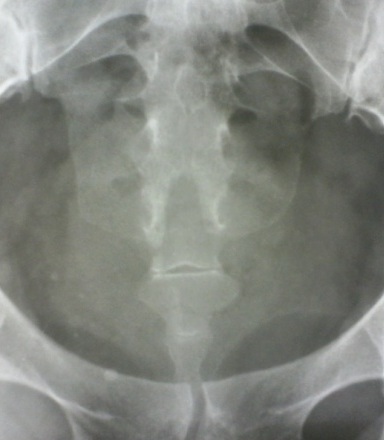
|
| Magnetic resonance imaging (MRI) | The most diagnostic methods by which the doctor determines a hernia of the spine, as well as an inflammatory process in the bladder. |
| Computed tomography (CT) | |
| Ultrasound examination (ultrasound) | A diagnostic method that is used to examine the pelvic organs and identify pathological processes. |
| Sphincterometry | Specialists study the functioning of the obturator of the anal sphincter. |
| Balloonography | Diagnostic method of examination, which allows you to identify violations in the structure of the intestine. |
It is important to differentiate the tailbone disease, since the therapy regimen depends on the correct diagnosis. Many pathologies of the musculoskeletal system are accompanied by similar clinical symptoms. Timely treatment will prevent possible complications.
Disease treatment methods
The tailbone is located in the back of the person in the lower part of the spine, the treatment is selected by the therapist, taking into account the cause of the disease and the patient's condition. Therapy is carried out by complex methods, it is important to adhere to all the prescriptions of a specialist in order to prevent the negative consequences of pathological processes.
Drugs
The doctor selects medications, guided by the results of a comprehensive diagnosis. Drugs must be taken, observing strictly the appointment, since the active ingredients provoke side effects.
Depending on the cause of the tailbone lesion, patients are prescribed the following medications: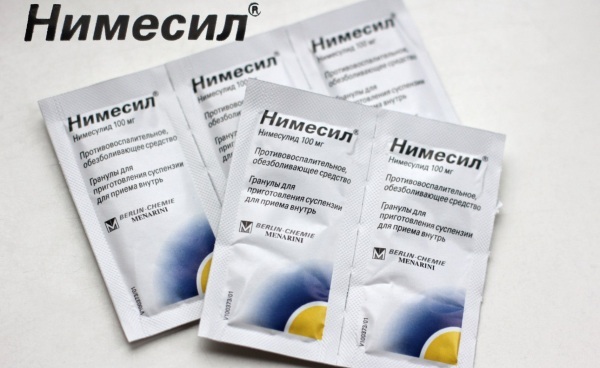
| Drug group | Name | Application |
| Non-steroidal anti-inflammatory drugs | Nimesulide, Ibuprofen | Medicines reduce pain and inflammation, are prescribed for osteochondrosis, sciatica, after injuries. The drugs must be taken orally 400 mg 3-4 times a day for 5 days. |
| Muscle relaxants | Mydocalm, Baclofen | Medicines help relax muscles, relieve tension and pain. The drugs are taken orally after meals, 50 mg 2-3 times a day. |
For topical use, patients are prescribed ointments, creams or gels (Ketoprofen, Piroxicam). Medicines have an anti-inflammatory effect, and are more often used for chronic diseases.
They also relieve minor painful sensations. The medicine is recommended to be applied to the affected area 2-3 times a day for 2-3 weeks. In case of inflammation, warming medications should not be used.
Surgical intervention
Surgical treatment for patients is indicated in the absence of positive dynamics after the use of drugs or in difficult situations.
The main indications for surgery:
- the appearance of fistulas;
- the development of an abscess;
- the onset of a tumor process;
- severe injury to the tailbone, during which bones and internal organs were damaged.
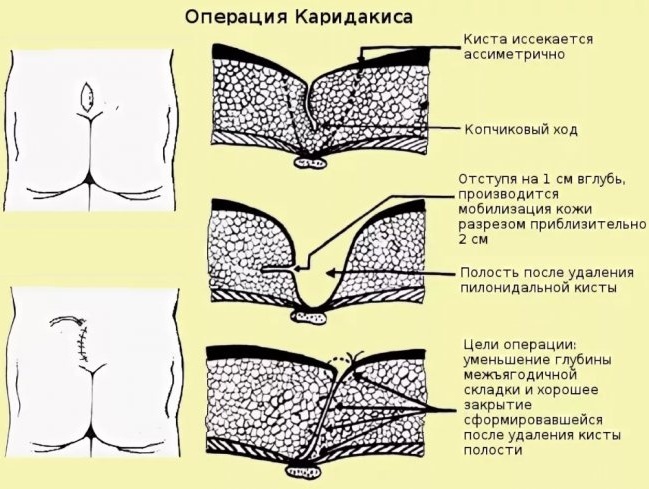
Surgical treatment for a person is necessary for a tailbone fracture, when unbearable painful sensations appear or the patient's quality of life is disturbed.
Folk remedies recipes
The tailbone can be treated with folk remedies, if there are no medical contraindications. It is impossible to get rid of pathologies with only recipes of healers and healers, therapy should be carried out using complex methods and after consultation with the attending physician.
It must be remembered that folk remedies can provoke an allergic reaction or individual sensitivity in the place where the tailbone of a person is located.
| Name | Recipe | Application |
| Blue clay | Mix 500 g of clay and 1 tbsp. vinegar. | The resulting mass must be applied to the affected area of the body, covered with a plastic bag and wrapped in a scarf. It is recommended to do a blue clay compress every day before going to bed. |
| Honey with radish | Combine 150 ml of radish juice and 3 tbsp. natural honey. Mix all components well. | The finished product must be rubbed into the affected area of the body 2-3 times a day with light massage movements. It is recommended to store the medicine in a cool place. |
| Comfrey ointment | Chop the leaves of the plant (1 tablespoon) and mix with vegetable oil (1 tablespoon). The resulting mass must be put on medium heat, brought to a boil and continue to heat for another 30 minutes. Cool, strain and add 1/3 tbsp. beeswax, also vitamin E. | It is recommended to store the finished product in a closed container. Comfrey ointment must be applied to the coccyx area and covered with a gauze bandage on top. |

Fir oil will help to cope with painful sensations in the coccyx area. It must be applied to the lower back in a small amount and rubbed gently with light massage movements. The tool has anti-inflammatory and analgesic effects.
Exercise therapy
In the complex therapy of the coccyx, patients are also recommended to perform therapeutic exercises. Exercise will help strengthen your back, pelvic floor, and abdominal muscles.
A set of classes will help you choose a physiotherapist, taking into account the person's condition and the development of the disease:
- Lie with your back on a flat surface. Spread the legs, bent at the knees, on different sides. Hands must be placed on the inside of the lower limbs. In this position, the legs must be moved, resisting with the hands. It is recommended to repeat the exercise 10 times.
- Take an upright body position, legs apart shoulder-width apart. Place the ball between them. It is necessary to squeeze it with your feet for 5-8 seconds, applying a large amount of effort. You cannot bend your legs. The exercise should be repeated 8 times.
- In an upright position with straight legs, you must also squeeze the ball with your hips for 5-8 seconds. It is important to ensure that the back is straight and the stomach does not fall out forward. The exercise should also be performed 8 times.
During exercise, patients should use a ball that absorbs the load on the spine. With him, the movements are rhythmic and smooth.
The tailbone, although it is a rudiment of the tail of the spine, is necessary for a person to perform numerous functions. The appearance of painful sensations in the area where it is located cannot be ignored. Timely diagnosis and correctly selected therapy will help prevent serious consequences.
Coccyx video
Anatomy of the tailbone, sacrum:



